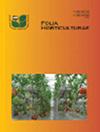The effect of application of effluent water on sage (Salvia officinalis L.) yield and quality in lysimeters
IF 1.8
4区 农林科学
Q2 HORTICULTURE
引用次数: 1
Abstract
ABSTRACT Cultivation of medicinal plants with the irrigation of agricultural effluents might be of great importance to save fresh water resources, extend cultivation area and increase economic feasibility. We investigated the effects of saline fish farm effluent water, diluted and gypsum-supplemented effluent, and natural freshwater as a control irrigation in lysimeters. Beside plant growth parameters, macronutrient and sodium content and the amount and composition of essential oil of sage plants were measured. Significant differences among irrigation treatments were found in plant height, SPAD value and essential oil content. Seasonal variation was also observed on plant height, nutrient content of the leaves and the total essential oil content. The essential oil components characterised by the highest levels of availability were detected as α-thujone, camphor, ß-thujone, 1,8-cineol and ledol. Under effluent irrigation, the concentrations of - and ß-thujone increased slightly; only camphene, trans-sabinole and caryophyllene-oxide changed significantly. The other main components remained stable. Our analysis of the response of sage to the input of effluent provides a reasonable ground for recommending the utilisation of saline effluent water from intensive fish farming in sage production, thus preventing the wastage of valuable water resources.污水处理对鼠尾草产量和品质的影响
利用农业废水灌溉栽培药用植物,对节约淡水资源、扩大种植面积、提高经济效益具有重要意义。我们研究了盐场废水、稀释和石膏补充废水以及天然淡水作为对照灌溉的效果。除测定植物生长参数外,还测定了鼠尾草植物的常量营养素和钠含量以及精油的含量和组成。不同灌溉处理在株高、SPAD值和挥发油含量上存在显著差异。株高、叶片养分含量和总挥发油含量也有季节变化。有效度最高的精油成分为α-图琼、樟脑、ß-图琼、1,8-桉叶油醇和ledol。出水灌溉下-和ß-图琼酮浓度略有升高;只有樟烯、反式松香素和石竹烯-氧化物变化显著。其他主要成分保持稳定。我们分析了鼠尾草对污水输入的反应,为建议在鼠尾草生产中使用集约化养鱼场排出的含盐污水提供了合理的依据,从而防止了宝贵水资源的浪费。
本文章由计算机程序翻译,如有差异,请以英文原文为准。
求助全文
约1分钟内获得全文
求助全文
来源期刊

Folia Horticulturae
Agricultural and Biological Sciences-Horticulture
CiteScore
3.40
自引率
0.00%
发文量
13
审稿时长
16 weeks
期刊介绍:
Folia Horticulturae is an international, scientific journal published in English. It covers a broad research spectrum of aspects related to horticultural science that are of interest to a wide scientific community and have an impact on progress in both basic and applied research carried out with the use of horticultural crops and their products. The journal’s aim is to disseminate recent findings and serve as a forum for presenting views as well as for discussing important problems and prospects of modern horticulture, particularly in relation to sustainable production of high yield and quality of horticultural products, including their impact on human health.
 求助内容:
求助内容: 应助结果提醒方式:
应助结果提醒方式:


